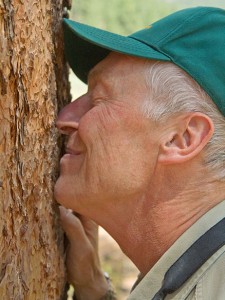
15 Oct EcoAction Partners: Mountain Facts, Terpenes
Editor’s note: Hilary Lempit of EcoAction Partners continues a new series called “Mountain Facts” that is all about answering your questions about the environment and sustainability. This week’s installment is about terpenes.

U.S. Forest Service guide Steve Hirst sniffs a Ponderosa pine during a July hike in Coconino National Forest.,” from NPR
Ever caught a whiff of vanilla, butterscotch, or a spicy scent when hiking through coniferous forests near Telluride? What you’re smelling is a group of organic chemicals released by coniferous trees, called terpenes.
Terpenes give our local ponderosas, lodgepoles, and spruces their distinctive and pungent “piney” (and sometimes sweet) fragrance. These chemicals are just beginning to be fully understood by scientists: some suggest terpenes enable trees to communicate. Terpenes have been observed to offer protection from grazing animals, pollution, and insects. Recent studies of coniferous forests suggest that trees releasing terpenes may even have a cooling effect on the climate due to chemical reactions in the atmosphere.
I notice the fragrance of our coniferous forests most when I’m skiing through the trees on a sunny winter day. But in warmer temperatures, or when the sun hits the tree bark, terpene production increases.
My suggestion for this week? Take a snowy hike up the Bear Creek Trail and immerse yourself in the gorgeous montane zone alongside the creek. Check out the lodgepole pines, Douglas firs, and Colorado blue spruce trees. If you’re feeling adventurous, stick your nose right against the bark, take a moment, and smell the sweet scent of our beautiful coniferous forests.


Sorry, the comment form is closed at this time.